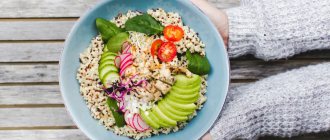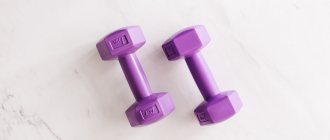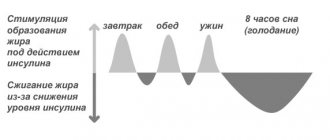Nutritionists assure: to maintain weight, it is important to count calories. But for some reason they forget to clarify what these calories should look like in terms of glasses and spoons. We took on this mission and asked a nutrition specialist to help with this difficult task.
“Yes, on the Internet you can easily find what 100 calories look like. But it turns out that this data is not accurate,” says Alisa Shabanova, development director and co-owner of GrinDin.
Sweets
They say: 4 tsp. strawberry jam.
Actually: True. The average calorie content of jam is 250−300 kcal, respectively, 4 tsp. − this is 20 g of jam, approximately 100 kcal.
They say: 25 M&M's.
Actually: False. The weight of 1 chocolate dragee is a little more than 1 g, and with peanuts even more - 2.4 g. At the same time, the calorie content of ordinary chocolate dragees is 470 kcal, 25 g is 117 kcal, but 24 pieces with peanuts is almost 60 g and about 300 kcal.
They say: 1 baked apple with honey and cinnamon.
Actually: True! But keep in mind that it all depends on the amount of honey. In order not to exceed 100 kcal, you need to take no more than 1 tablespoon (10 g) of honey. The calorie content of 1 apple (medium, weighing 150 g) is 70 kcal, and 1 tsp. honey - 16 kcal.
table of CALORIES OF GRAINS AND FLOUR PRODUCTS
| Name | Calories/100 g of product | Name | Calories/100 g of product |
| Baranki | 314 | Beans | 58 |
| Peas | 324 | Green peas | 272 |
| Buckwheat | 329 | Corn grits | 326 |
| Semolina | 333 | Oatmeal | 370 |
| Pearl barley | 328 | Millet groats | 334 |
| Barley groats | 324 | Cornflakes | 370 |
| Pasta | 340 | Wheat flour | 350 |
| Rye flour | 347 | Cereals | 305 |
| Table cookies | 420 | Rice | 332 |
| Polished rice | 343 | Baking | 304 |
| Soybeans | 395 | Road rusks | 360 |
| Drying | 330 | Beans | 310 |
| Darnitsky bread | 205 | Wheat bread | 226 |
| Rye bread | 210 | Barley flakes | 310 |
Nuts
They say: 14 almonds
10 cashews
77 pine nuts
23 pistachios
In fact: Nuts are a complete snack. 100 g of nuts is 550-600 kcal. In order not to exceed the specified 100 kcal, you need to eat no more than 20 g! It is better, of course, to use scales, because nuts are very different in size, and here you can make a mistake by 1.5-2 times.
Physical exercise
To maximize the effect of the diet, you need to “make friends” with physical education. If a well-designed diet helps you lose weight, then strength training will allow your body to remain in good shape with strong muscles and smooth, toned skin.
Physical activity should not be a heavy burden, but a pleasant experience. Therefore, you need to choose what you like.
Lots of options:
- Running or walking;
- A ride on the bicycle;
- Yoga;
- Pilates;
- Group fitness;
- Swimming;
- Dancing;
- Exercises in the gym.
You can get quite a lot of extra calories from drinking. So, sweet carbonated drinks and packaged juices are clearly not good for your figure. It is better to opt for freshly squeezed juices with a weak consistency, unsweetened teas and coffee, and drink clean still water between meals.
If preference is given to an active sport, it is recommended to include protein in the diet. It is protein-containing products that are responsible for muscle structure and the quality of body appearance.
Just 30-45 minutes of exercise a day on a regular basis, and your body will thank you.
Flour
They say: 6 small dryers.
In fact: The calorie content of dryers is 350 kcal. If 1 drying weighs 5 g, then this is exactly the correct calculation.
They say: 1/5 cup dry pasta.
In fact: If you really want to, you can use a glass instead of a scale. Take this into account: 1/2 cup will fit 100 g of dry and small ones - that’s about 300 kcal.
They say: 4 crackers.
In fact: Crackers are different. Their calorie content varies from 400 to 500 kcal. If 1 cracker weighs 5 g, then 4 pieces are 20 g, and their calorie content is almost 100 kcal.
They say: 1/8 of a croissant with chocolate
Reality: Again, croissants are very different. They come in weights of 40, 60, 80 and 120 g. The calorie content, accordingly, will also be different. If we take a croissant with chocolate, then we can talk about 400 kcal per 100 g.
All the pros and cons
As with any weight loss method, the Tammy and Susie Trimble diet has its pros and cons.
Pros of the diet:
- All gastronomic delights are permitted. A person who is losing weight will feel like a full-fledged member of society. If you want to have lunch at fast food - please; The birthday boy treats you to a piece of cake - no problem, the main thing is to invest in 100 calories.
- To calculate the energy value of your diet, you need to learn about the calorie value of many foods - this knowledge will become useful even after you quit the diet.
- Weight will decrease gradually , which will have a positive effect on the quality of the skin and will not cause harm to the body as a whole.
Disadvantages of the diet:
- To comply with the calorie norm, the menu must be drawn up in advance.
- For overly active people, an energy value of 1500-2000 calories per day will not be enough; they will feel weak and apathetic.
- When you end the diet and go back to your usual high-calorie eating plan, the lost pounds may return.
The 100 calorie weight loss system does not involve anything new - all development concepts boil down to the fact that a person learns to “read” the calorie content of his diet. Having understood the calculations of calorie intake during a diet, you can easily control food portions and keep yourself in shape in the future.
THESE ARTICLES WILL HELP YOU LOSE WEIGHT
Dairy
They say: 1 glass of 3% kefir
In fact: Exactly right!
They say: 1 tablespoon sour cream 42%
Not really. 1 tablespoon is about 10 g. The calorie content of 40% sour cream is approximately 400 kcal, that is, 10 g is 40 kcal.
They say: 1 tablespoon of condensed milk
Not really. The calorie content of condensed milk is 320 kcal per 100 g, that is, in 1 tbsp. l. - 10 g, which is only 32 kcal.
They say: 2 palms of low-fat cottage cheese
Actually: No comment. Who measures cottage cheese with their palms?
table of CALORIES OF FRUITS AND BERRIES
| Name | Calories/100 g of product | Name | Calories/100 g of product |
| Apricot | 50 | Avocado | 99 |
| Quince | 30 | Cherry plum | 37 |
| A pineapple | 45 | Orange | 40 |
| Watermelon | 40 | Bananas | 100 |
| Cowberry | 41 | Grape | 70 |
| Cherry | 50 | Blueberry | 37 |
| Pomegranate | 54 | Greyfruit | 36 |
| Pear | 44 | Melon | 50 |
| Blackberry | 33 | Strawberries | 37 |
| Raisin | 287 | Figs | 56 |
| Kiwi | 49 | Dogwood | 40 |
| Cranberry | 29 | Gooseberry | 43 |
| Dried apricots | 298 | Lemon | 31 |
| Raspberries | 41 | Mandarin | 41 |
| Cloudberry | 30 | Sea buckthorn | 31 |
| Peach | 44 | Rowan | 56 |
| Plum | 44 | Black currant | 45 |
| Red currants | 43 | Dates | 280 |
| Dried apricots | 278 | Cherries | 52 |
| Persimmon | 63 | Prunes | 226 |
| Blueberry | 44 | Apple | 45 |
| Mulberry | 44 | Dried apples | 271 |
table of calorie content of meat products and eggs
| Name | Calories/100 g of product | Name | Calories/100 g of product |
| Mutton | 207 | Ham | 370 |
| Beef | 158 | Brisket | 470 |
| Korean | 430 | Goose | 395 |
| Turkey | 207 | Turkey | 230 |
| Smoked sausage | 510 | Amateur sausage | 300 |
| Brain sausage | 342 | Moscow sausage | 470 |
| Ukrainian sausage | 350 | Tea sausage | 180 |
| Rabbit meat | 120 | Chicken | 185 |
| Ham | 360 | Liver pate | 315 |
| Beef liver | 90 | Beef kidneys | 60 |
| Salami | 560 | Sausages | 150 |
| Pork | 390 | Heart | 90 |
| Sausages | 200 | Duck | 410 |
| Pheasant | 145 | Lard | 660 |
| Beef tongue | 279 | Pork tongue | 300 |
| Egg, 1 pc. | 75 | Egg powder | 550 |
How many calories are in a kilocalorie?
A calorie is a unit that measures the energy value of any food. It is also used to measure energy and work. A kilocalorie is a calorie reduced by a thousand times. They can be compared, like, for example, grams and kilograms. It turns out, if we remember physics, a calorie is equal to 4.18 Joules, respectively, a kilocalorie is equal to 4018 J. There are 1000 calories in one kilocalorie.
What else is the calorie famous for? It indicates the amount of energy that will be expended when heating one gram of pure water by one degree Celsius. But, basically, few people think about the importance of calories. It’s much more common to use them to find out the calorie content of what’s on the table.
CALORIES OF VEGETABLES, GREENS AND MUSHROOMS
| Name | Calories/100 g of product | Name | Calories/100 g of product |
| Eggplant | 22 | White fresh | 25 |
| White dried | 210 | Broccoli | 34 |
| Swede | 37 | Fresh mushrooms | 30 |
| Zucchini | 14 | White cabbage | 25 |
| Brussels sprouts | 13 | Sauerkraut | 22 |
| Kohlrabi cabbage | 30 | Red cabbage | 27 |
| Savoy cabbage | 35 | Cauliflower | 18 |
| Cauliflower | 18 | Potato | 90 |
| Chestnuts | 210 | Kohlrabi | 27 |
| Celery root | 38 | Corn | 105 |
| Green onion | 18 | Bulb onions | 50 |
| Olives | 350 | Butter | 25 |
| Carrot | 40 | Fresh cucumbers | 15 |
| Pickles | 8 | Fresh honey mushrooms | 20 |
| Parsnip | 18 | Sweet pepper | 18 |
| Parsley | 42 | Fresh boletus | 32 |
| Fresh boletuses | 32 | Rhubarb | 16 |
| Radish | 20 | Radish | 26 |
| Turnip | 22 | Salad | 18 |
| Beet | 50 | Celery | 21 |
| Asparagus | 21 | Fresh russula | 18 |
| Tomatoes | 17 | Pumpkin | 28 |
| Dill | 29 | White beans | 350 |
| Green beans | 34 | Sorrel | 28 |
| Horseradish | 70 | Zucchini | 30 |
| Cheremsha | 35 | Garlic | 96 |
| Champignon | 25 | Spinach | 18 |
CALORIES IN DRINKS
| Name | Calories/100 g of product | Name | Calories/100 g of product |
| Apricot juice | 57 | Pineapple juice | 45 |
| Orange drink (fizzy) | 43 | Orange juice | 40 |
| Dry white wine | 66 | Dry red wine | 68 |
| Grape juice | 52 | Cherry juice | 53 |
| Water | 0 | Grapefruit juice | 35 |
| Kvass | 25 | Cranberry juice | 51 |
| Coca-Cola (LITE) | 43 | Black coffee (no sugar) | 0 |
| Lemonade | 37 | Mineral water | 0 |
| carrot juice | 27 | Beer | 32 |
| Tomato juice | 15 | Dry champagne | 85 |
| Apple juice | 43 | Champagne sweet | 90 |
Calories love counting!
Some may not know, but per kilogram of human body weight there is one calorie per hour. So, for example, for 55 kilograms, a person spends 55 kilocalories per hour. For the first half of the day, from breakfast at 8.00 to lunch at 13.00, you need to consume foods containing 275 kilocalories. Having made the necessary calculations, it turns out that to maintain the required energy supply for the whole day, 1320 kilocalories will be required. Their number will be different for women - approximately 1500 per day, and for men 1700. These figures do not take into account additional kilocalories, for example, for the functioning of the digestive organs you need almost 200 calories per day. Each person has their own physical activity during the day, which also requires additional energy reserves.
table of calorie content of fish and seafood
| Name | Calories/100 g of product | Name | Calories/100 g of product |
| Gobies | 145 | Pink salmon | 148 |
| Granular caviar | 250 | Chum salmon caviar | 255 |
| Pollock caviar | 131 | Pressed caviar | 237 |
| Squid | 80 | Flounder | 93 |
| crucian carp | 88 | Carp | 89 |
| Chum salmon | 140 | Smelt | 90 |
| Crab | 70 | Shrimp | 85 |
| Far Eastern shrimp | 135 | Icy | 75 |
| Bream | 100 | Salmonidae | 405 |
| Sea salmon | 190 | Macrurus | 60 |
| Mussels | 75 | Lamprey | 165 |
| Pollock | 70 | capelin | 156 |
| Shellfish | 85 | Sea kale | 8 |
| Navaga | 73 | Burbot | 80 |
| Marbled notothenia | 160 | Sea bass | 110 |
| River perch | 85 | Lobster | 85 |
| Sturgeon | 165 | Halibut | 102 |
| Cod liver | 615 | Haddock | 168 |
| Blue whiting | 72 | Saber fish | 113 |
| Caspian fisherman | 97 | Fish fingers | 200 |
| Carp | 120 | Large saury | 260 |
| Small saury | 142 | Salaka | 120 |
| Stellate sturgeon | 136 | Herring | 240 |
| Salted herring | 260 | Salmon | 220 |
| Whitefish | 145 | Mackerel | 153 |
| Som | 160 | Horse mackerel | 120 |
| Sterlet | 325 | Zander | 72 |
| Zander | 70 | Trepang | 37 |
| Cod | 65 | Tuna | 97 |
| coal fish | 160 | Acne | 335 |
| Sea eel | 95 | Trout | 210 |
| Hake | 85 | Sprats in oil | 250 |
| Pike | 73 | Ide | 120 |
CALORIE CONTENT OF SWEETS, ICE CREAM AND CONFECTIONERY PRODUCTS
| Name | Calories/100 g of product | Name | Calories/100g product |
| Strawberry jam | 310 | Apple jam | 350 |
| Waffles with fat-containing fillings | 540 | Waffles with fruit fillings | 345 |
| Bakery | 400 | Marshmallow | 330 |
| Fruit candies | 400 | Caramel | 295 |
| Marmalade | 295 | Chocolate coated candies | 398 |
| Milk ice cream | 140 | Honey | 320 |
| Ice cream | 185 | Ice cream sundae | 230 |
| Paste | 305 | Popsicle ice cream, creamy | 275 |
| Shortcake | 445 | Baked pies | 220 |
| Puff pastry with apple | 454 | Cream cake | 540 |
| Jam | 280 | Cakes | 430 |
| Sugar | 400 | Gingerbread | 335 |
| Almond cake | 530 | Sponge cake with fruit filling | 390 |
| Halva | 500 | Chocolate cake | 490 |
| Dark chocolate | 545 | Milk chocolate | 550 |











